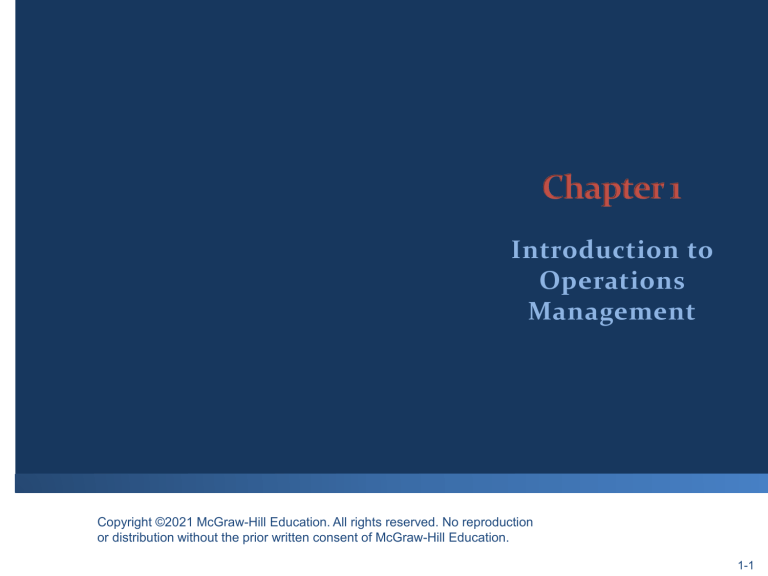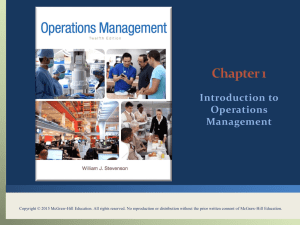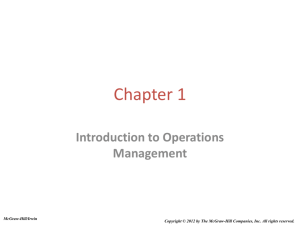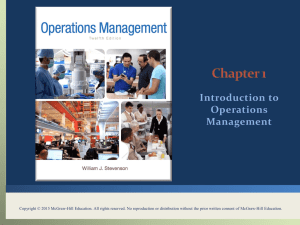
Introduction to Operations Management Copyright ©2021 McGraw-Hill Education. All rights reserved. No reproduction or distribution without the prior written consent of McGraw-Hill Education. 1-1 What is operations management ? Why is it important ? What do operations management professionals do ? What is operations? Operations is what businesses do Operations are processes that either provide service or create products Operations take place in businesses such as restaurants, retail stores, factories, hospitals, and universities How can we define operations management? The management of systems or processes that create goods and/or provide services 1-3 Goods are physical items that include raw materials, parts, subassemblies, and final products • Automobile • Computer • Oven • Shampoo Services are activities that provide some combination of time, location, form or psychological value • Air travel • Education • Haircut • Legal counsel Ideal situation for a business organization is to achieve an economic match of supply and demand • Excess supply or excess capacity is wasteful and costly • Having too little means lost opportunity and possible customer dissatisfaction 1-4 Organization Marketing Operations Finance Finance is responsible for securing financial resources at favorable prices and allocating those resources throughout the organization Marketing is responsible for assessing consumer wants and needs, and selling and promoting the organization’s goods or services Operations is responsible for producing the goods or providing the services offered by the organization Operations management is the management of systems or processes that create goods and/or provide services Operations and supply chains are intrinsically linked, and no business organization could exist without both Supply chain – a sequence of activities and organizations involved in producing and delivering a good or service Suppliers’ suppliers Direct suppliers Producer Distributor Final customers Functions and activities include forecasting, purchasing, inventory management, information management, quality assurance, scheduling, production, distribution, delivery, and customer service 1-6 Value-Added Inputs Transformation/ Conversion Process •Land •Labor •Capital •Information Measurement and Feedback Feedback : Outputs •Goods •Services Measurement and Feedback Measurement and Feedback Control Measurements taken at various points in the transformation process Control : The comparison of feedback against previously established standards to determine if corrective action is needed The essence of the operations function is to add value during the transformation process 1-8 1-9 • Two factors affect the management of operations systems are the degree of involvement of customers in the process and the degree to which technology is used to produce and/or deliver a product or service • Products are typically neither purely service- or purely goods-based Goods Services Surgery, Teaching Songwriting, Software Development Computer Repair, Restaurant Meal Home Remodeling, Retail Sales Automobile Assembly, Steelmaking 1-10 Production of goods results in a tangible output (automobile, eyeglasses, refrigerator) anything that we can see or touch Delivery of service generally implies an act (physician’s examination, TV repair, lawn care) Manufacturing and service are often different in terms of what is done, but quite similar in terms of how it is done 1. Degree of customer contact 2. Labor content of jobs 3. Uniformity of inputs 4. Uniformity of output 5. Measurement of productivity 6. Production and delivery 7. Quality assurance 8. Amount of inventory 9. Wages 10. Ability to patent 1-11 1-12 Every aspect of business affects or is affected by operations Operations and sales are two most important functions in a business organization All other functions support these two functions Many service jobs are closely related to operations Financial services (e.g., stock market analyst, investment banker) Marketing services (e.g., market analyst, marketing researcher) Accounting services (e.g., corporate accountant, public accountant) Information services (e.g., corporate intelligence, library services) Through learning about operations and supply chains you will have a better understanding of: The world you live in The global dependencies of companies and nations Reasons that companies succeed or fail The importance of working with others 1-13 Finance & operations management personnel cooperate by exchanging information and expertise in such activities: Budgeting Economic analysis of investment proposals Provision of funds Marketing’s focus is on selling and/or promoting p the goods or services of an organization Accessing customer wants and needs Communicating those to operations people (short) oand to design people (long term) Marketing, design, and production must work closely together to successfully implement design changes and to develop and produce new products 1-14 One important piece of information marketing needs from operations is the manufacturing or service lead time in order to give customers realistic estimates of how long it will take to fill their orders • Lead time: time between ordering a good or service and receiving it Marketing, operations, and finance must interface on product and process design, forecasting, setting realistic schedules, quality and quantity decisions, and keeping each other informed on the other’s strengths and weaknesses Operations manager Supply chain manager Production analyst Schedule coordinator Production manager Industrial engineer Purchasing manager Inventory manager Quality manager 1-16 A key aspect of operations management is process management Process - one or more actions that transform inputs into outputs Businesses are composed of many interrelated processes Three Categories of Business Processes: Upper-management processes Operational processes Supporting processes These govern the operation of the entire organization. (Ex: organizational governance and organizational strategy) These are core processes that make up the value stream. (Ex: purchasing, production and /or service, marketing, and sales) These support the core processes. (Ex: accounting, human resources, and IT) 1-17 Ideally, the capacity of a process will be such that its output just matches demand Supplier(s) Input(s) from one or more suppliers A business organization, a department, or an individual operations Transformation Customer(s) Output(s) to one or more customers Business processes form a sequence of suppliers and customers Operations & Supply Chains Supply Sales & Marketing > Demand Supply < Demand Supply = Demand Wasteful Costly Opportunity Loss Customer Dissatisfaction Ideal 1-19 Variation occurs in all business processes Variations can be disruptive to operations and supply chain processes They may result in additional costs, delays and shortages, poor quality, and inefficient work systems Four Sources of Variation: Variety of goods or services being offered The greater the variety of goods and services offered, the greater the variation in production or service requirements Structural variation in demand These are generally predictable. They are important for capacity planning Random variation Natural variation that is present in all processes. Generally, it cannot be influenced by managers Assignable variation Variation that has identifiable sources. This type of variation can be reduced, or eliminated, by analysis and corrective action 1-20 The scope of operations management ranges across the organization. The operations function includes many interrelated activities such as (EX: airline company): Forecasting : weather and landing conditions, seat demand for flights, growth in air travel Capacity planning: essential for the airline to maintain cash flow and make a reasonable profit (too few or too many will hurt profits) Locating facilities: according to managers’ decisions on which cities to provide service for, where to locate maintenance facilities, and where to locate major and minor hubs Facilities and layout: important in achieving effective use of workers and equipment 1-21 The operations function includes many interrelated activities such as (EX: airline company): Scheduling : scheduling of pilots and flight attendants, and scheduling of ground crews, counter staff, and baggage handlers Managing inventories : items as foods an beverages, first-aid equipment, in-flight magazines, pillows and blankets, and life preservers Assuring quality : the emphasis is on safety. Dealing with customers at ticket counters, check-in where the emphasis is on efficiency and courtesy Motivating and training employees : in all phases of operations • The Operations function consists of all activities directly related to producing goods or providing services. • A primary function of the operations manager is to guide the system by decision making • Certain decisions affect the design of the system, and others affect the operations of the system System design decisions System operation decisions 1-23 • System design involves decisions that relate to – – – – System Capacity Facility location Facility layout Product and service planning Acquisition and placement of equipment • These are typically strategic decisions that - usually require long-term commitment of resources - determine parameters of system operation 1-24 • System operation • These are generally tactical and operational decisions – – – – – Management of personnel Inventory management and control Scheduling Project management Quality assurance • Operations managers spend more time on system operation decision than any other decision area - They still have a vital stake in system design 1-25 Most operations decisions involve many alternatives that can have quite different impacts on costs or profits Operations management (OM) professionals make a number of key decisions that affect the entire organization Typical operations decisions include: What: What resources are needed, and in what amounts? When: When will each resource be needed? When should the work be scheduled? When should materials and other supplies be ordered? Where: Where will the work be done? How: How will the product or service be designed? How will the work be done? How will resources be allocated? Who: Who will do the work? 1-26 Modeling is a key tool used by all decision makers Model - an abstraction of reality; a simplification of something Common features of models: They are simplifications of real-life phenomena They omit unimportant details of the real-life systems they mimic so that attention can be focused on the most important aspects of the real-life system Physical Model – miniature airplane; advantage is its visual correspondence with reality Schematic Model – drawing of a city (blueprints); advantage is often relatively simple to construct and change, some degree of visual correspondence Mathematical Model – Inventory optimization (numbers, formulas); it is the easiest to manipulate and important forms of inputs for computers and calculators 1-27 Keys to successfully using a model in decision making What is its purpose? How it is used to generate results? How these results are interpreted and used? What are the model’s assumptions and limitations? 1-28 1. Generally easier to use and less expensive than dealing with the real system 2. Require users to organize and sometimes quantify information 3. Increase understanding of the problem 4. Enable managers to analyze “What if?” questions 5. Serve as a consistent tool for evaluation and provide a standardized format for analyzing a problem 6. Enable users to bring the power of mathematics to bear on a problem 1-29 Quantitative information may be emphasized at the expense of qualitative information Models may be incorrectly applied and the results misinterpreted This is a real risk with the widespread availability of sophisticated, computerized models placed in the hands of uninformed users The use of models does not guarantee good decisions 1-30 A decision-making approach that frequently seeks to obtain a mathematically optimal solution Supported by computer calculations Often work together with qualitative • Quantitative approaches are widely used in operation management decision making • Managers typically use a combination of qualitative and quantitative approaches, and many important decisions are based on qualitative approaches 1-31 Performance metrics All managers use metrics to manage and control operations Profits Costs Quality Productivity Flexibility Inventories Schedules Forecast accuracy Analysis of trade-offs A trade-off is giving up one thing in return for something else Carrying more inventory (an expense) in order to achieve a greater level of customer service Additional inventory would yield and the increased costs required to stock that inventory 1-32 System - a set of interrelated parts that must work together The business organization is a system composed of subsystems Marketing subsystem Operations subsystem Finance subsystem The systems perspective Emphasizes interrelationships among subsystems Main theme is that the whole is greater than the sum of its parts The output and objectives of the organization take precedence over those of any one subsystem 1-33 In nearly all cases, certain issues or items are more important than others Recognizing this allows managers to focus their attention to those efforts that will do the most good Pareto Phenomenon - a few factors account for a high percentage of occurrence of some event(s) The critical few factors should receive the highest priority This is a concept that is appropriately applied to all areas and levels of management 1-34 Operations management is primarily concerned with three kinds of technology : • Product and service technology : discovery and development of new products and services (researchers and engineers) • Process technology : methods, procedures, and equipment used to produce goods and provide services • Information technology (IT) : science and use of computers and other electronic equipment to store, process, and send information (electronic data processing, use of bar codes to identify and track goods, obtaining POS information, data transmission, internet, e-commerce, e-mail) All three can have a major impact on costs, productivity, and competitiveness Global competition • It has broadended the scope of SCM • More challenges and uncertainties • Put more emphasis on operations strategy, working with fewer resources, revenue management, process analysis and improvement, quality improvement, agility and lean production Working with fewer resources • Layoffs, corporate downsizing, and general cost cutting are forcing managers to make trade-off decisions on resource allocation Agility • Ability of an organization to respond quickly to demands or opportunities • More important under the Increasingly shorter product life cycles Lean systems • They use much less of certain resources to produce a high volume of high-quality goods with some variety • It uses a highly skilled workforce and flexible equipment Economic conditions • Have created uncertainties for decision makers Innovating • It can be made in processes, use of the internet, or supply chain that reduce costs, increase productivity, expand markets, or improve customer service Quality problems • Related to product design and testing, oversight of suppliers, risk assessment, and timely response to potential problems 1-38 Risk management It starts with identifying risks, assessing vulnerability and potential damage (liability costs, reputation, demand) and taking steps to reduce or share risks Cyber-security The need to guard against intrusions from hackers is becoming increasingly necessary More interconnected systems increase intrusion risks Competing in a global economy • Low labor costs in un-developed countries have increased pressure to reduce labor costs • Weight options including outsourcing some or all of their operations to low-wage areas, reducing costs internally, changing designs, and working to improve productivity Sustainability Using resources in ways that do not harm ecological systems that support human existence All areas of business will be affected Product and service design Consumer education programs Disaster preparation and response Supply chain waste management Outsourcing decisions 1-40 Ethics - a standard of behavior that guides how one should act in various situations Ethical issues that may arise in many aspects of operations management: Financial statements : accurately representing organization’s financial condition Worker safety : providing adequate training, maintaining equipment in good working condition, maintaining a safe working environment Product safety : providing products that minimize the risk of injury to users or damage to property or the environment Quality : honoring warranties, avoiding hidden defects The environment : not doing that will harm the environment The community : being a good neighbor Hiring and firing workers : avoiding false pretenses (i.e., promising a long-term job what that is not what is intended) Closing facilities : taking into account the impact on a community, and honoring commitments that have been made Workers’ rights : respecting workers’ rights, dealing with workers’ problems quickly and fairly 1-41 In the past, organizations did little to manage the supply chain beyond their own operations and immediate suppliers which led to numerous problems Oscillating inventory levels Inventory stockouts Late deliveries Quality problems 1-42 1. 2. The need to improve operations • Efforts on cost and time reduction, and productivity and quality improvement • Opportunity now lies largely with procurement, distribution, and logistics (supply chain) Increasing levels of outsourcing • Buying goods or services instead of producing or providing them in- house • As outsourcing increases, some organizations are spending increasing amount on supply-related activities (wrapping, packing, moving, loading and unloading, and sorting) 3. Increasing transportation costs • Transportation costs are increasing, and they need to be more carefully managed 4. Competitive pressures • Increasing number of new products, shorter product development cycles, and increased demand for customization • Adoption of quick-response strategies and efforts to reduce lead times 1-43 Increasing globalization 5. • • It has expanded the physical length of supply chain Having far-flung customers and/or suppliers means longer lead times and greater opportunities for disruption of deliveries Increasing importance of e-business 6. • It has added new dimensions to business buying and selling and has presented new challenges The complexity of supply chains 7. • • Complex, dynamic, and many inherent uncertainties Inaccurate forecasts, late deliveries, substandard quality, equipment breakdowns, and canceled or changed orders The need to manage inventories 8. • • Important to coordinate inventory levels throughout a supply chain Shortage and/or excess





